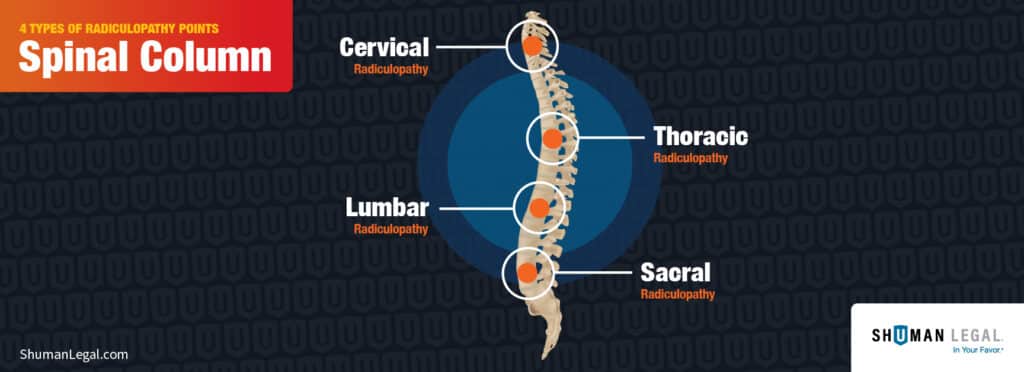Key Takeaways
- The VA determines radiculopathy disability ratings using specific diagnostic codes based on the affected nerve group—cervical, lumbar, or thoracic—with symptoms and impact on movement dictating the rating percentage.
- To increase their VA radiculopathy rating, veterans should provide comprehensive medical evidence and documentation detailing the effects on daily life, and strongly articulate the intensity and limitations of symptoms during exams.
- Veterans can file for secondary service connection compensation for radiculopathy if it is a result of a primary service-connected condition, and they may be eligible for TDIU benefits if radiculopathy significantly impairs their ability to gain employment.
Your search for help ends here. Let’s get started, for FREE.
Understanding VA Radiculopathy Ratings
Radiculopathy is a condition characterized by nerve pain and numbness, often resulting from cervical, lumbar, or thoracic nerve damage in the spinal column. The VA uses specific diagnostic codes and criteria from the Schedule for Rating Disabilities to determine the severity of radiculopathy. These codes are grouped based on the affected nerve group, with separate categories for cervical, lumbar, and thoracic radiculopathy.
The unique symptoms experienced by veterans factor into the VA disability rating system, with disability ratings ranging from 10% to 90%, depending on the severity and impact on movement. Veterans must have a formal diagnosis of radiculopathy to be eligible for service-connected compensation.
Rating Criteria for Different Types of Radiculopathy
Cervical radiculopathy, often the result of a pinched nerve in the neck, is evaluated under VA diagnostic codes 8510, 8610, and 8710. Symptoms typically include sharp pain, weakness, and numbness that radiate down the arms into the hands.
On the other hand, lumbar radiculopathy, commonly known as sciatica, is evaluated under VA diagnostic codes 8520, 8620, and 8720. It involves the irritation of the sciatic nerve, causing pain or numbness in the leg, affecting the lumbar spine, lower back, and limbs.
Thoracic radiculopathy, although less common, causes symptoms such as pain, numbness, or tingling in the torso regions, including the chest, abdomen, or around the ribcage.
The Bilateral Factor in VA Ratings
The bilateral factor comes into play when conditions affect both sides of the body. Radiculopathy impacting both sides results in separate disability ratings for each side, potentially increasing the overall disability compensation.
Veterans with radiculopathy on both sides should be aware of the bilateral factor as it may substantially increase their overall disability compensation. It underscores the importance of comprehensive medical evaluations that accurately reflect the full extent of a veteran’s condition, including the risk of complete paralysis.
How to Increase Your VA Radiculopathy Rating
By scheduling diagnostic tests with a trusted medical professional prior to the VA exam, veterans can enhance their VA radiculopathy claim. Providing this evidence can significantly strengthen their rating.
But it doesn’t stop with medical evidence. Veterans also need to demonstrate the impact of their condition on their daily life. This involves accurately describing the intensity and limitations caused by radiculopathy symptoms during examinations and in documentation.
Providing Strong Medical Evidence
Supporting a VA radiculopathy claim necessitates evidence from relevant diagnostic tests like CT scans, MRIs, or X-rays. Robust medical documentation should include detailed records from Compensation and Pension exams and expert medical opinions evaluating the condition.
When attending Compensation and Pension examinations, veterans need to accurately describe the intensity and impact of their radiculopathy symptoms to ensure an appropriate disability rating. In addition to medical records, statements from knowledgeable individuals and service treatment records can fortify their claims.
Were You Denied Veteran Benefits?
Demonstrating the Impact on Daily Life
Symptoms like pain, numbness, or weakness from radiculopathy can notably hinder a veteran’s performance of daily tasks. The VA evaluates the severity of radiculopathy based on how the condition’s symptoms, such as:
- restricted movement
- difficulty with fine motor skills
- inability to lift or carry objects
- trouble with balance or coordination
interfere with daily life.
Activities like walking or standing for extended durations can exacerbate the symptoms of lumbar radiculopathy, affecting daily activities that involve these movements. Therefore, veterans must ensure these impacts are accurately captured during their examinations and in their documentation.
Secondary Service Connection and Radiculopathy
Veterans can secure extra compensation for service connected radiculopathy associated with other service-linked disabilities through secondary service connection. Eligibility for secondary service connection compensation is based on radiculopathy being a secondary service disability caused or aggravated by a direct service-connected condition.
Veterans with radiculopathy as a secondary service-connected condition can have their ratings combined with other disabilities to achieve an overall total rating for compensation. This underscores the importance of understanding the interactions between different service-connected conditions.
Examples of Common Secondary Conditions
Radiculopathy often arises as a secondary condition from primary conditions affecting the spine. Common primary conditions that can lead to secondary radiculopathy include:
- Back strain
- Spinal injury
- Degenerative disc disease
- Degenerative arthritis
- Osteoarthritis
- Spinal stenosis
Spinal stenosis, characterized by the narrowing of the spinal canal, can press on nerves and contribute to radiculopathy, often resulting from a compressed nerve root. Similarly, bulging or herniated discs pressing on the nerves are a common cause of radiculopathy. Awareness of these underlying conditions, including the impact on the spinal cord and potential spinal injuries, can help veterans understand and articulate their full medical picture.
TDIU Benefits for Veterans with Radiculopathy
TDIU benefits grant veterans, with less than 100% disability ratings but incapacitated by radiculopathy, compensation commensurate with a 100% rating. Veterans with a combined disability rating of 70% or higher, with one disability rated at least 40%, may be eligible for TDIU benefits, also known as va disability benefits.
Radiculopathy can make it difficult to hold steady employment due to persistent pain and limitations. Claims for Individual Unemployability require medical evidence showing that service-connected disabilities, often resulting from military service, prevent veterans from securing or maintaining substantially gainful employment.
Filing a Successful VA Radiculopathy Claim
To file a successful VA radiculopathy claim, veterans need to provide evidence encompassing diagnostic tests, medical history, service records, and a Compensation and Pension exam. Veterans can file a VA disability claim for radiculopathy online, by mail, in person, or by fax, and may submit an ‘intent to file’ form to preserve their compensation start date while gathering evidence.
Proof of the condition’s onset during service or its aggravation by a pre-existing condition is necessary, and veterans might be required to undergo further claim exams after filing. If a radiculopathy claim is denied, veterans have the options of Supplemental Claim, Higher-Level Review, or Board Appeal for further consideration.
Working with a VA Disability Lawyer
Veterans with denied radiculopathy claims can obtain valuable help from a VA disability lawyer who will strive to prove their entitlement to benefits for the condition. These lawyers are instrumental in navigating the complexities of the appeals process for radiculopathy claims, ensuring proper management of deadlines and submission of required paperwork.
Resources like Veterans Guide offer valuable information to veterans on how to file a claim and where to find the necessary legal assistance for radiculopathy-related disabilities. With a skilled VA disability lawyer, veterans can make sure their claims are strongly supported and accurately reflect the impact of their condition.
Frequently Asked Questions
What is the average VA rating for radiculopathy?
The average VA rating for radiculopathy ranges from 10 to 40 percent, depending on the severity of the symptoms. Severe cases may result in a higher rating.
What is radiculopathy secondary to?
Radiculopathy is often secondary to degenerating discs, which can lead to spinal instability and conditions like bulging discs, spinal stenosis, and herniated discs.
What is considered severe radiculopathy?
Severe radiculopathy is characterized by sensory loss and pain with marked motor deficits, indicating a more significant impact on movement and sensation. This distinction helps in understanding the severity of the condition.
Can you get disability for radiculopathy?
Yes, you may qualify for long-term disability benefits if your radiculopathy significantly impairs you from performing the material duties of your occupation.
What is the average VA disability rating for cervical radiculopathy?
The average VA disability rating for cervical radiculopathy is 20% to 50%.













